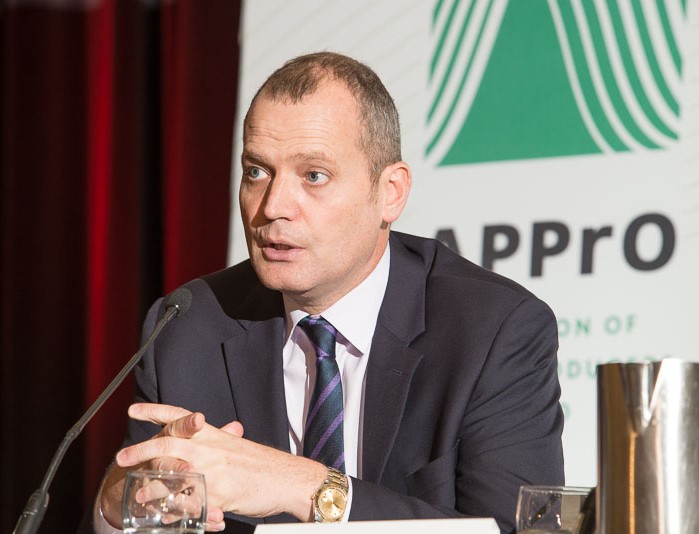By Sean Mallen
A roomful of diverse players in the energy field had barely finished their coffees and settled into their seats for the first session of the APPrO 2017 conference when their Monday morning brains were challenged to look at the world in a whole new way.
In a wide-ranging and thought provoking presentation, Jan Vrins, the Global Energy Practice Leader at Navigant, told them that their businesses are not only changing dramatically, but that the pace of change is accelerating.
“Think about new business models. The future is here,” he said.
 Jan Vrins speaking at the APPrO 2017 Conference, November 20 2017
Jan Vrins speaking at the APPrO 2017 Conference, November 20 2017
He cited three forces that are upending the status quo: market demand, technology and innovation and regulation and policy. He spoke about the emergence of the “Energy Cloud”, where old energy infrastructure is being replaced with cleaner, more distributed, more intelligent systems. Vrins said in the emerging world of distributed energy resources and engaged, empowered, consumers, utilities may well evolve into what he called “energy cloud platform orchestrators”.
To cope with the forces of change, he advised pursuing two parallel tracks. Track one, which he characterized as playing defence, centred on ensuring that core businesses remain cost effective and resilient, freeing up resources to invest. Track two, playing offence, would mean focusing on growth opportunities around the energy cloud.
It was a mind-expanding opening to a conference with the theme of “Future + Focus”, setting the stage for a series of conversations about how the energy sector in Ontario and beyond is coping with a world where the landscape is constantly and unpredictably shifting.
They likely have never had to deal with so many complex, challenging and profound factors at the same time: the Long Term Energy Plan (LTEP), market renewal, climate change initiatives, technological innovation and an impending provincial election.
“The big issue in Ontario is change,” said APPrO CEO Dave Butters in a session called Setting Directions: What Generators are concerned about.
“Trying to understand what that change looks like and still be able to ride it in a way that allows you to get a return on your assets and survive with minimal damage. And still be able to take advantage of new opportunities,” he added.
Brian Bentz, CEO Alectra Utilities, said that the concept of a top-down grid has been turned on its head: “this is a reset, from a 100% centralized system to some amount of distribution. It becomes an ecosystem of energy. That’s where the investment opportunity is. “
Ron Dizy, from the Advanced Energy Centre at MaRS said that regulators are having difficulty keeping up and he highlighted what he called the “new participant in the market: the customer.”
Dizy said that they want more control: “They don’t care about stranded assets. If we don’t keep on top of this, it won’t be a smooth transition, it’ll be messy. We have to figure out how to do disruption without damage. There will be some losers.”
A key player in it all is the new CEO of IESO, Peter Gregg. Only a few months on the job, he acknowledged in a speech to the conference that energy planning is no longer a top-down process and he highlighted the importance of stakeholder input to the market renewal process, which he referred to as “managing the decentralized grid of tomorrow”.
“If we do it right, there’ll be benefits to all of Ontario,” he said.
Those who have participated in the consultations have spoken about the long hours and the challenging complexities. Leonard Kula, the COO of IESO, is leading the market renewal process and he told the conference he is well aware of it.
“I know we’re asking a lot of you. We will be reaching out to you, we want to know how we can streamline the process and where to improve,” he said.
In his keynote speech to the convention, Energy Minister Glenn Thibeault touted the potential of market renewal, calling it a “transformative fix to the system” and saying that improved efficiencies could bring up to $5 billion in savings.
“Our government aims to minimize costs by maximizing use of existing assets,” he said.
But while market renewal promises to bring a new face to the Ontario energy sector, our democratic system is also hurtling towards its own form of renewal—next June’s election. With the Liberals under Premier Kathleen Wynne trailing, but the result wildly unpredictable, everyone must prepare for the possibility that there could be a change at Queen’s Park, with new faces at the helm.
